<< Previous | Displaying results 5251-5275 of 6769 for "" | Next >>
1991 photograph of Aron and Lisa's granddaughters, Courtney and Lindsay. The eldest, Courtney, graduated from Harvard Business School in 2004.

The extended Derman family. Top row, left to right: Aron, Lisa, Howard, Miriam, Daniel, Ari, Gordon, and Barbara (Howie's wife). Front row, left to right: Rachel, Yali, Evan, Gabe, Courtney, Ben, and Lindsay.
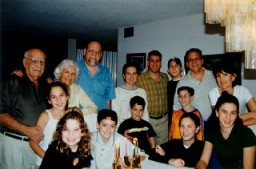
Aron and Lisa in Poland, ca. 1994, while accompanying high school students as part of a "Shoreshim" group.

Lisa and Aron with Chicago Mayor Richard Daley on Holocaust Remembrance Day. Chicago, Illinois, 1994 or 1995.
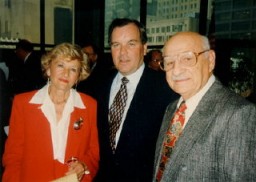
Aron and Lisa with the Emmy they won for their 1997 documentary, A Journey of Remembrance. Photograph taken in Northbrook, Illinois, 1998.
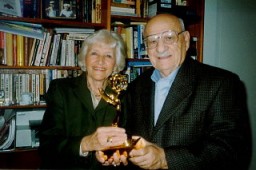
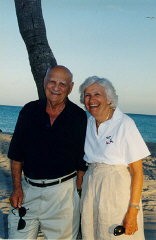
Cover of a memorial booklet for Lisa Derman (Lisa Derman: An Extraordinary Woman, An Extraordinary Life, published by Louis Weber Publications International, Ltd.).

Aron Derman and Neenah Ellis look at one of Aron's family photographs. 2004.
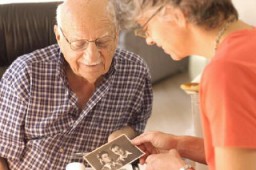
Aron was born to a middle-class Jewish family in Slonim, a part of Poland between the two world wars. His parents owned a clothing store. After studying in a technical school, Aron worked as a motion-picture projectionist in a small town near Slonim. The Soviet army took over Slonim in September 1939. War broke out between Germany and the Soviet Union in June 1941. Aron returned to Slonim. The Germans soon occupied Slonim, and later forced the Jews into a ghetto.
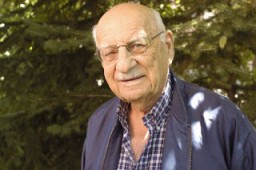
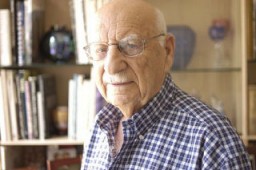
Thomas at age 13 months with his father, Mundek Buergenthal. Czechoslovakia, June 1935.
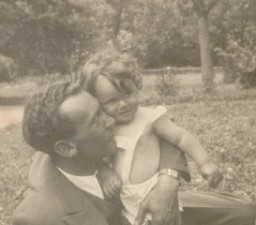
Thomas Buergenthal's parents, Mundek and Gerda (b. 1912). Czechoslovakia, 1933 or 1934. With the end of World War II and collapse of the Nazi regime, survivors of the Holocaust faced the daunting task of rebuilding their lives. With little in the way of financial resources and few, if any, surviving family members, most eventually emigrated from Europe to start their lives again. Between 1945 and 1952, more than 80,000 Holocaust survivors immigrated to the United States. Thomas was one of them.
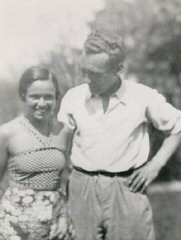
Three-year-old Thomas Buergenthal during a stay at a hotel in Czechoslovakia, 1937. With the end of World War II and collapse of the Nazi regime, survivors of the Holocaust faced the daunting task of rebuilding their lives. With little in the way of financial resources and few, if any, surviving family members, most eventually emigrated from Europe to start their lives again. Between 1945 and 1952, more than 80,000 Holocaust survivors immigrated to the United States. Thomas was one of them.
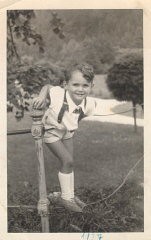
Three-year-old Thomas Buergenthal with his parents, Mundek and Gerda. Czechoslovakia, June 1937. With the end of World War II and collapse of the Nazi regime, survivors of the Holocaust faced the daunting task of rebuilding their lives. With little in the way of financial resources and few, if any, surviving family members, most eventually emigrated from Europe to start their lives again. Between 1945 and 1952, more than 80,000 Holocaust survivors immigrated to the United States. Thomas was one of them.
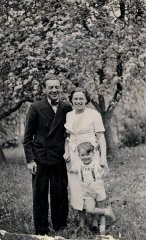
Photograph of a young Thomas Buergenthal posing in his toy car as his mother sits alongside. 1936.
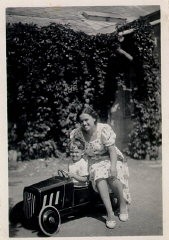
Thomas (left), 6 months after liberation, with a soldier who realized that Thomas was Jewish and took him to an orphanage, ca. 1945. Thomas was eventually reunited with his mother. With the end of World War II and collapse of the Nazi regime, survivors of the Holocaust faced the daunting task of rebuilding their lives. With little in the way of financial resources and few, if any, surviving family members, most eventually emigrated from Europe to start their lives again. Between 1945 and 1952, more than…
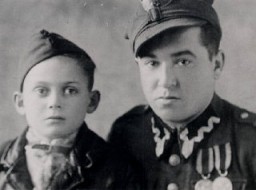
Thomas Buergenthal with his mother, Gerda, in Goettingen, Germany, 1950. With the end of World War II and collapse of the Nazi regime, survivors of the Holocaust faced the daunting task of rebuilding their lives. With little in the way of financial resources and few, if any, surviving family members, most eventually emigrated from Europe to start their lives again. Between 1945 and 1952, more than 80,000 Holocaust survivors immigrated to the United States. Thomas was one of them.
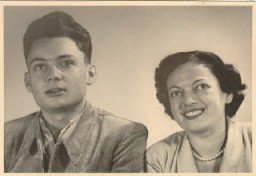
Thomas Buergenthal with his mother, Gerda, before Thomas's departure for the United States. Bad Neuheim, Germany, summer 1951. With the end of World War II and collapse of the Nazi regime, survivors of the Holocaust faced the daunting task of rebuilding their lives. With little in the way of financial resources and few, if any, surviving family members, most eventually emigrated from Europe to start their lives again. Between 1945 and 1952, more than 80,000 Holocaust survivors immigrated to the United…
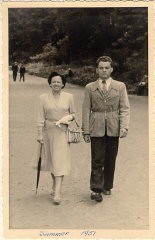
Thomas (standing, right), then known as "Tommy," with relatives shortly after arriving in the United States. New Jersey, ca. 1952. With the end of World War II and collapse of the Nazi regime, survivors of the Holocaust faced the daunting task of rebuilding their lives. With little in the way of financial resources and few, if any, surviving family members, most eventually emigrated from Europe to start their lives again. Between 1945 and 1952, more than 80,000 Holocaust survivors immigrated to the United…
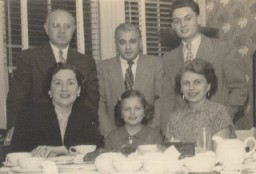
Thomas Buergenthal as a student at New York University, 1957–60. With the end of World War II and collapse of the Nazi regime, survivors of the Holocaust faced the daunting task of rebuilding their lives. With little in the way of financial resources and few, if any, surviving family members, most eventually emigrated from Europe to start their lives again. Between 1945 and 1952, more than 80,000 Holocaust survivors immigrated to the United States. Thomas was one of them.
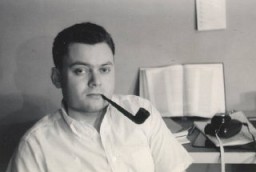
Thomas Buergenthal as a law student, 1959–60. With the end of World War II and collapse of the Nazi regime, survivors of the Holocaust faced the daunting task of rebuilding their lives. With little in the way of financial resources and few, if any, surviving family members, most eventually emigrated from Europe to start their lives again. Between 1945 and 1952, more than 80,000 Holocaust survivors immigrated to the United States. Thomas was one of them.
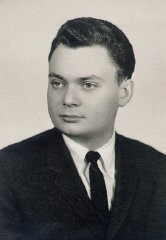
Thomas with his first wife, Dorothy, at the Zeta Tau Alpha Spring Formal, 1957. With the end of World War II and collapse of the Nazi regime, survivors of the Holocaust faced the daunting task of rebuilding their lives. With little in the way of financial resources and few, if any, surviving family members, most eventually emigrated from Europe to start their lives again. Between 1945 and 1952, more than 80,000 Holocaust survivors immigrated to the United States. Thomas was one of them.
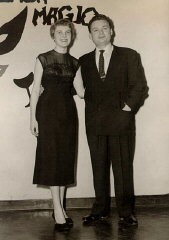
Judge Thomas Buergenthal, member of the Inter-American Court of Human Rights, San Jose, Costa Rica, 1980.

Photograph taken in 1984 of Thomas Buergenthal's mother, Gerda, then in her early 70s.
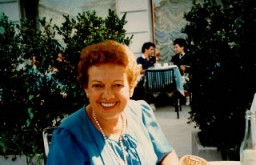
Judge Thomas Buergenthal (front row, right) with other members of the Inter-American Court of Justice in San Jose, Costa Rica. Thomas served from 1979–91 and was president from 1985-1987. San Jose, Costa Rica, 1980.
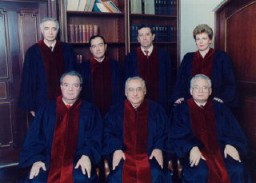
We would like to thank Crown Family Philanthropies, Abe and Ida Cooper Foundation, the Claims Conference, EVZ, and BMF for supporting the ongoing work to create content and resources for the Holocaust Encyclopedia. View the list of donor acknowledgement.